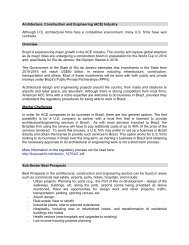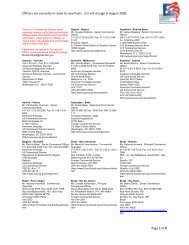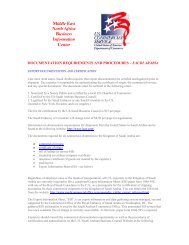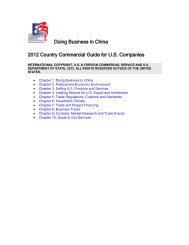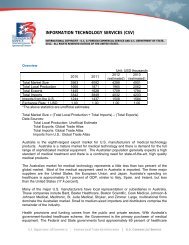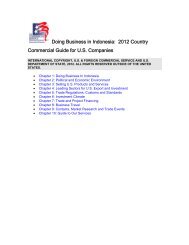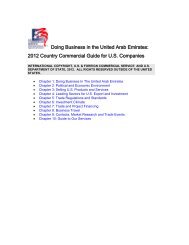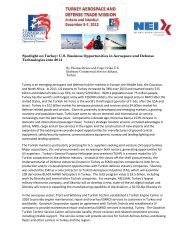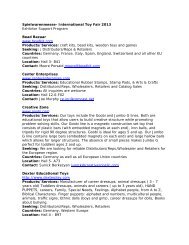Healthcare Technologies Resource Guide - Export.gov
Healthcare Technologies Resource Guide - Export.gov
Healthcare Technologies Resource Guide - Export.gov
Create successful ePaper yourself
Turn your PDF publications into a flip-book with our unique Google optimized e-Paper software.
will also spur the demand for specialized wound care and easy-to-use home care products for diabetes,<br />
orthopedic appliances, and dialysis equipment.<br />
The trend is toward miniaturization of electro-medical equipment and nanotechnology products. New<br />
technologies in emergency and first responder care along with computer-assisted surgery are widely<br />
discussed among the German medical community. German companies generate about a third of their<br />
sales with products that are no more than 3 years old and approximately 9% of their sales are reinvested<br />
in research.<br />
As public insurance funds (the reimbursers of medical devices) continue to record deficits, cost<br />
containment will remain a priority. Thus, price-competitive state-of-the-art technologies and equipment<br />
offering proven cost savings will have strong market potential.<br />
Registration Process<br />
The CE Mark signifies that a product fulfills all necessary EU requirements. CE marking is now a legal<br />
requirement for a wide range of equipment manufacturers in Germany. Certification requirements for<br />
use of the CE mark vary depending on the product. For some, such as those in the MPG low risk class I,<br />
the manufacturers (or importer/ authorized representative, if the product is manufactured outside the<br />
EU) may self- certify compliance with EU requirements and affix the mark; for others the certification of<br />
a “notified body” (an accredited certification agency such as the TUEV) will be required. For the medical<br />
aids sector, the workability and safety of a product is now considered satisfied by CE marking. The CE<br />
mark is a visible indication that the manufacturer signed a “Declaration of Conformity” prior to affixing<br />
the CE mark, claiming compliance with all relevant CE marking directives in force.<br />
All electro-medical equipment in Germany must be suitable for use with 220 Volt, 50 cycle electrical<br />
current, and should have VDE or TUEV approval. A UL approval is not a substitute but is helpful to<br />
obtain “GS/VDE”, or GS/TUEV” approval in Germany. “GS” stands for “gepruefte Sicherheit” (safety<br />
tested). Although “GS” and the “VDE” (or “GS and TUV”) marks are not required by law, they are highly<br />
recommended for marketing electro-medical goods in Germany. These labels denote high product<br />
safety; German consumers look for these labels as Americans do for the “UL” mark.<br />
The U.S. Product Safety Testing Institute, Underwriters Laboratories (UL), the VDE Testing and<br />
Certification Institute, and the TUEV Product Service, have formed a strategic alliance for testing<br />
of electromagnetic compatibility (EMC) which has resulted in globally recognized EMC test mark.<br />
For manufacturers of electrical and electronic products, this cooperation has led to a substantive<br />
simplification of EMC testing. Through a single test carried out by one of these three partners, a product<br />
can now be awarded an international EMC mark, which replaces the national test marks in the major<br />
world markets of Europe, the USA and Japan.<br />
Barriers<br />
Firms exporting medical devices to Germany will not encounter any direct trade barriers or quotas.<br />
Non-tariff, indirect trade barriers could include the complex German reimbursement system, the need<br />
for additional registration procedures in the case of medical assistive technologies, for example, or<br />
products sold in pharmacies, with the requirement to apply for HMV or PZN codes, respectively. For Class<br />
2 medical products, the German medical products law requires manufacturing and distribution control/<br />
quality control documentation.<br />
U.S. Commercial Service <strong>Healthcare</strong> <strong>Technologies</strong> <strong>Resource</strong> <strong>Guide</strong> | 2012–2013<br />
47





